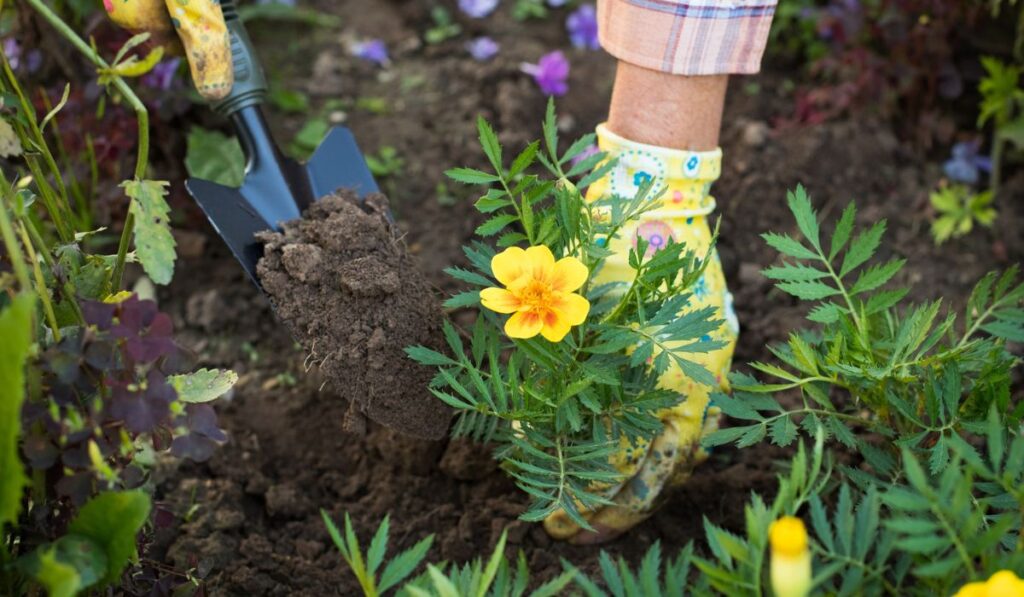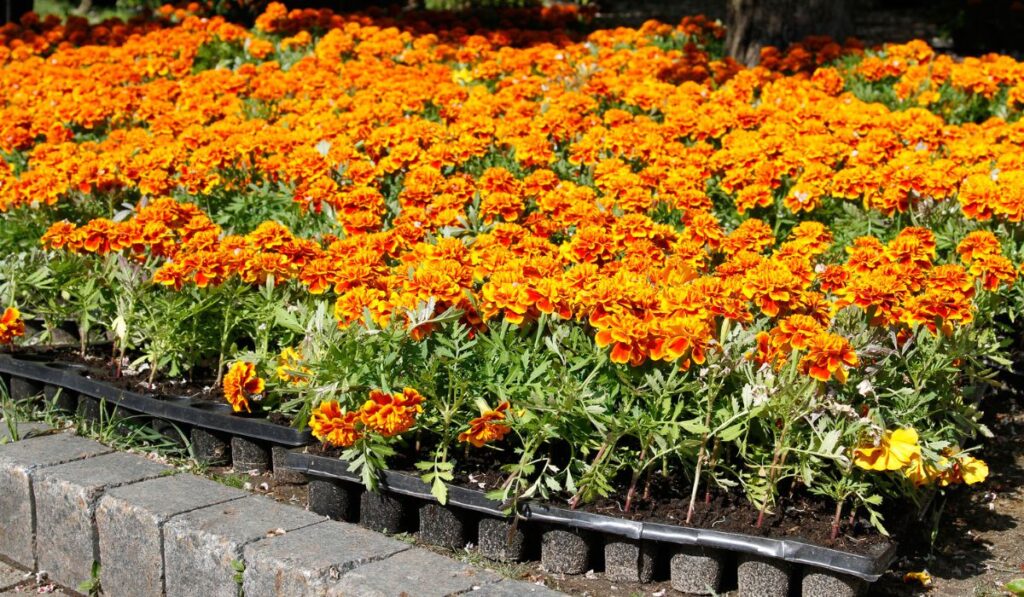Marigolds are known for their large, bright-colored flowers of yellow, orange, and maroon. No wonder they are a fought after plant to have in every garden. From being the centerpiece of color to lining a vegetable garden, marigolds make an excellent addition year long.
The best time to plant marigolds is between May and June, although you can start indoor sowing as early as February. Marigolds grow in full sun and tolerate drought-like conditions, and are great at repelling pests, often used as companion plants for vegetable gardens.
Marigolds range from a few inches high to a few feet tall in various widths and colors. Figuring out what kind of marigold would work best in your garden is as simple as deciding what color and size you want, as every marigold is hardy and easy to care for.
When Should You Plant Marigolds?

There are two different groups of marigolds, the Calendula and Tagetes variety. Each comes with its own recommendation on when to plant them.
Calendula Marigolds
Calendula marigolds, which would be included in most marigold seed mixes (on Amazon), are hardy annuals that can be sown indoors from March to May. Then in May and June, you can plant them directly outside for flowers during the summer.
You can also forgo the indoor planting and skip to starting them in the soil in late spring. Calendula marigolds can also be planted in August or September for pre-emptive flowers the following year.
Tagetes Marigolds
There are two ways to plant Tagetes, indoors or outdoors. If you want to begin the seeds indoors, it is best to start six to eight weeks before the last frost with a steady temperature of 70 to 75 degrees Fahrenheit or 21 to 24 degrees Celsius. Germination takes five to seven days.
The ideal indoor sowing period is in February, but French marigolds can be started in March or April, like the Calendula variety. African marigolds can be sown indoors two to three weeks earlier than French marigolds since they take longer to flower.
To plant outdoors, you need to have passed the last frost, or they will die, so roughly May or June.
Types of Marigolds
Marigolds have all been categorized by the general public as American or French, but in reality, there are tons of variety, and most of them are aromatic, some even edible.
Calendula Marigold Types
Calendula officinalis, also known as pot marigolds or English marigolds, are native to southern Europe and not actually a marigold but a cousin to them. The flower is bright, edible with a tangy, peppery taste, and often grown in kitchen herb gardens.
Tagetes Marigold Types
Although there are more than fifty species of marigolds, the most common belong to the Tagetes family. Several larger varieties of Tagetes are then broken down into the individual series.
Tagetes Erecta
The African, American, or Mexican marigold is the tallest variety of all the marigolds. They reach roughly 3 to 4 feet and produce large flowers. They are native to both Mexico and Central America and can tolerate drought-like conditions.
- Jubilee Series: 2’ tall plants that are dense with double flowers in shades of yellow and orange.
- Gold Coin Series: 1½ to 2’ tall with 5” wide flowers in gold, yellow, and orange.
- Safari Series: 1’ tall plants with flat-topped flowers in maroon, yellow, and orange.
- French Vanilla: 1½ to 2’ tall plants with 3” wide flowers in a creamy white.
Tagetes Patula
French marigolds are more petite, bushier, and much more compact than other varieties. They grow wider instead of tall and produce modest flowers. The flowers tend to be dual carnations with varying degrees of yellow, orange, and maroon. They can grow roughly 6 inches to 2 feet in height and are better suited for wetter conditions than other marigold species.
- Little Hero Series: 7” tall with wide flowers.
- Hero Series: 10” tall with 2” wide flowers.
- Bonanza Series: 8” tall, bushy plants with 2” wide flowers.
- Aurora Series: 1’ tall with large petaled, anemone-like flowers.
- Janie Series: 8” tall, early blooming plants suitable for containers.
- Boy O’ Boy Series: 6” tall plants that bloom pretty often.
Tagetes Tenuifolia
Signet marigolds are the smallest variety that rarely reaches a foot in height. They produce small flowers that do well in hot and dry locations and are often used as edging plants.
Are Marigolds High Maintenance?
Marigolds are one of the easiest plants to take care of. It is near impossible to kill them since they can tolerate infrequent watering and lots of sunlight.
Marigolds are so easy to take care of that they are often used as a companion plant to vegetable gardens. In addition, the French marigold is known to repel nematodes (microscopic worms) that attack root vegetables.
To utilize this natural repellent quality in marigolds, it is best to plant a bunch in the spring next to where you plan to grow a fall crop. Then, in mid to late summer, you should remove the marigolds when you plant your crops. They can then be transplanted to another garden to continue enjoying their beautiful bloom.
How to Grow Marigolds
Growing marigolds is pretty straightforward. They grow in most soil types and can bloom all year long. Due to this reason, it is unnecessary to start marigolds indoors since the delicate seedlings can tolerate harsh weather.
Planting
Planting marigolds depends on the size of the variety you are dealing with. For larger marigolds, you should sow the seeds roughly 18 to 24 inches apart, mediums require 12 to 15 inches apart, and the dwarf varieties should be spaced 6 inches apart.
After planting the seeds in the soil, all you have to do is cover the garden bed to keep them warm and moist. After a couple of days, they will sprout, and the first bloom will appear within two months.
Container Planting
If you have planted the marigolds in a container, overcrowding can become an issue since they are fast-growing plants. Make sure you use a large enough pot to accommodate how wide the plant will become.
Using a soil-based potting mix (on Amazon), add granular for more air circulation and a slow-acting fertilizer. You can also periodically water them with a diluted liquid fertilizer (on Amazon). Just be sure now to over-fertilize as this can burn the roots.
Thinning
Once the seeds have sprouted, it will be time to thin them. Thinning seedlings is vital to the health of a maturing plant, so they don’t get overcrowded and become nutrient deficient. On top of this, there is also the added benefit that air can circulate around each seedling to prevent mildew and mold from growing in the damp and moist conditions.
To thin a seedling, carefully remove the seedling from the soil, roots intact. Holding it by the leaves to prevent any unnecessary crushing of the stem, plant that seedling in another spaced out hole. Gently pat the soil around the roots and give the seedlings a good watering.
After they are thinned, it is just a matter of watering regularly and enjoying the blooms!
What Climates do Marigolds Grow Best in?

The best spot where you can plant marigolds is in full sun. They thrive in all-day sunlight but can tolerate part shade as well. Warm climates work best for optimal growing and are great at blooming even in hot, dry summers.
African, American, and Mexican marigolds are incredibly hardy and can tolerate drought-like conditions. So forgetting to water them a few times won’t kill them, but they still need regular watering.
French marigolds thrive in wetter conditions, so keeping their soil moist is ideal. However, they, too, live well through the hot summers and still appreciate the full sun.
Marigold Care Tips
- Once the marigolds have become established, pinch off the tops of the plant to encourage them to grow bushier, or else they may become a bit leggy.
- Deadheading will encourage the plant to bloom more frequently. To do this, simply pinch or cut off the fading flower head to the nearest leaves.
- Allow the soil to dry in between watering, and do not overwater.
- Water at the base of the plant to avoid mildew growth on the leaves.
- Add mulch around the seedlings once they have sprouted to prevent weeds from taking over and help keep the soil moist.
- Don’t fertilize during the growing season as the nitrogen will create fantastic foliage, but your flowers will be lackluster.
Preventing Disease and Pests
Since marigolds are usually companion plants used to ward off pests, they have few pests that will bother them.
Spider Mites and Aphids
Among the few issues are spider mites or aphids. To handle these pests, simply use a spray bottle with insecticidal soap and spray the entire plant every other day for a couple of weeks.
If you want to save money, you can easily make your own insecticidal soap by mixing 2.5 tablespoons of vegetable oil, 2.5 tablespoons of liquid soap, and a gallon of distilled water.
Slugs and Caterpillars
If you notice holes in the leaves or chewed edges, you might have an infestation of slugs or caterpillars. Marigolds are a slug’s favorite meal, which is why they are often planted at the edge of a garden, so the slug goes for the marigold rather than the vegetables.
To get rid of caterpillars or slugs, manually hand pick each slug and dispose of them in the late evening when temperatures are cool.
Diseases
Among the few issues that can arise with marigolds are fungal diseases. A common threat is powdery mildew that grows on the marigold leaves.
This forms on the plant by having too wet conditions, and a good rule of thumb is to allow the soil to dry in between watering. You can also avoid this disease by watering at the base of the plant rather than over top.
